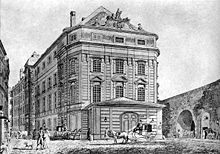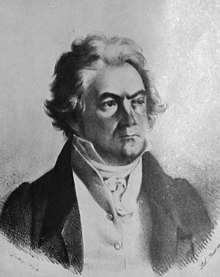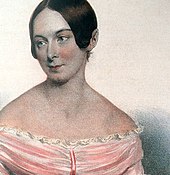台北書緣 (38))談"premier"一字。 讀《首演》First Nights:Five Musical Premieres ; 以"Symphony No. 9 (Beethoven)"為例,Angela Merkel served alongside four U.S. presidents,... prime ministers, premiers
https://www.facebook.com/hanching.chung/videos/1811083632417250
premiere, croon, premier, lido, Lido, 《首演》First Nights:Five Musical Premieres.presidents, prime ministers, premiers
Symphony No. 9 (Beethoven)"
Premiere[edit]
Although most of his major works had been premiered in Vienna, Beethoven was keen to have his latest composition performed in Berlin as soon as possible after finishing it, as he thought that musical taste in Vienna had become dominated by Italian composers such as Rossini.[11] When his friends and financiers heard this, they urged him to premiere the symphony in Vienna in the form of a petition signed by a number of prominent Viennese music patrons and performers.[11]
Beethoven was flattered by the adoration of Vienna, so the Ninth Symphony was premiered on 7 May 1824 in the Theater am Kärntnertor in Vienna along with the overture The Consecration of the House (Die Weihe des Hauses) and three parts of the Missa solemnis (the Kyrie, Credo, and Agnus Dei). This was the composer's first onstage appearance in 12 years; the hall was packed with an eager audience and a number of musicians.[12]
The premiere of Symphony No. 9 involved the largest orchestra ever assembled by Beethoven[12] and required the combined efforts of the Kärntnertor house orchestra, the Vienna Music Society (Gesellschaft der Musikfreunde), and a select group of capable amateurs. While no complete list of premiere performers exists, many of Vienna's most elite performers are known to have participated.[13]
The soprano and alto parts were sung by two famous young singers: Henriette Sontag and Caroline Unger. German soprano Henriette Sontag was 18 years old when Beethoven personally recruited her to perform in the premiere of the Ninth.[14][15] Also personally recruited by Beethoven, 20-year-old contralto Caroline Unger, a native of Vienna, had gained critical praise in 1821 appearing in Rossini's Tancredi. After performing in Beethoven's 1824 premiere, Unger then found fame in Italy and Paris. Italian composers Donizetti and Bellini were known to have written roles specifically for her voice.[16] Anton Haizinger and Joseph Seipelt sang the tenor and bass/baritone parts, respectively.
Although the performance was officially directed by Michael Umlauf, the theatre's Kapellmeister, Beethoven shared the stage with him. However, two years earlier, Umlauf had watched as the composer's attempt to conduct a dress rehearsal of his opera Fidelio ended in disaster. So this time, he instructed the singers and musicians to ignore the almost completely deaf Beethoven. At the beginning of every part, Beethoven, who sat by the stage, gave the tempos. He was turning the pages of his score and beating time for an orchestra he could not hear.[17]
There are a number of anecdotes about the premiere of the Ninth. Based on the testimony of the participants, there are suggestions that it was under-rehearsed (there were only two full rehearsals) and rather scrappy in execution.[18] On the other hand, the premiere was a great success. In any case, Beethoven was not to blame, as violinist Joseph Böhm recalled:
When the audience applauded—testimonies differ over whether at the end of the scherzo or symphony—Beethoven was several bars off and still conducting. Because of that, the contralto Caroline Unger walked over and turned Beethoven around to accept the audience's cheers and applause. According to the critic for the Theater-Zeitung, "the public received the musical hero with the utmost respect and sympathy, listened to his wonderful, gigantic creations with the most absorbed attention and broke out in jubilant applause, often during sections, and repeatedly at the end of them."[20] The audience acclaimed him through standing ovations five times; there were handkerchiefs in the air, hats, and raised hands, so that Beethoven, who they knew could not hear the applause, could at least see the ovations.[21]
首映[編輯]
雖然他的大部分主要作品都曾在維也納首演,但貝多芬希望他的最新作品完成後儘快在柏林上演,因為他認為維也納的音樂品味已被羅西尼等意大利作曲家所主導。[11]當他的朋友和金融家聽到這個消息時,他們敦促他以一些著名的維也納音樂贊助人和表演者簽署的請願書的形式在維也納首演這首交響曲。[11]
貝多芬是由維也納的崇拜不敢恭維,所以第九交響曲是1824年5月7日在首播劇場我Kärntnertor在維也納的序曲一起議院的奉獻(模具渭河DES Hauses)和三部分莊嚴彌撒曲(中Kyrie、Credo 和 Agnus Dei)。這是作曲家 12 年來首次登台演出;大廳裡擠滿了熱切的觀眾和許多音樂家。[12]
第 9 號交響曲的首演涉及貝多芬有史以來最大的管弦樂隊[12],需要 Kärntnertor 室內管弦樂隊、維也納音樂協會 ( Gesellschaft der Musikfreunde ) 和一群有能力的業餘愛好者共同努力。雖然不存在首演表演者的完整名單,但眾所周知,維也納許多最優秀的表演者都參加了。[13]
在高音和中音:部分由兩位著名青年歌手演唱亨麗埃特·桑塔格和卡羅琳·安熱。德國女高音亨麗埃特·桑塔格 (Henriette Sontag) 年僅 18 歲,貝多芬親自邀請她參加第九交響曲的首演。[14] [15]也被貝多芬親自招募,20 歲的女低音卡羅琳·昂格爾,維也納人,在 1821 年出現在羅西尼的坦克雷迪中,獲得了評論界的好評。在貝多芬 1824 年的首演演出後,昂格爾隨後在意大利和巴黎聲名鵲起。眾所周知,意大利作曲家多尼采蒂和貝里尼專門為她的聲音創作了角色。[16] Anton Haizinger和Joseph Seipelt 分別演唱了男高音和低音/男中音部分。
儘管演出由劇院的首席指揮邁克爾·烏姆勞夫( Michael Umlauf ) 正式執導,但貝多芬與他同台演出。然而,兩年前,烏姆勞夫親眼目睹了這位作曲家為他的歌劇《費德里奧》進行彩排的嘗試以一場災難告終。所以這一次,他指示歌手和音樂家不要理會幾乎完全失聰的貝多芬。在每一部分的開始,坐在舞台旁的貝多芬都給了節奏。他正在為一個他聽不見的管弦樂隊翻動他的樂譜和節拍。[17]
關於第九集的首映,有許多軼事。根據參與者的證詞,有人認為它排練不足(只有兩次完整的排練),並且在執行時相當草率。[18]另一方面,首映式取得了巨大的成功。無論如何,貝多芬都不應受到指責,正如小提琴家約瑟夫·博姆( Joseph Böhm)回憶的那樣:
當觀眾鼓掌時——對於是在諧謔曲還是交響曲結尾,證詞有所不同——貝多芬離開了幾個小節,仍在指揮。正因為如此,女低音卡羅琳·昂格爾走過來,把貝多芬轉過身來接受觀眾的歡呼和掌聲。據《劇院報》評論家稱,“公眾以最大的尊重和同情來接待這位音樂英雄,全神貫注地聆聽他美妙而巨大的創作,並在歡呼聲中爆發出熱烈的掌聲,經常是在片段中,並反复在他們的結局。” [20]觀眾起立鼓掌五次; 空中有手帕,有帽子,有高舉的手,讓他們知道聽不到掌聲的貝多芬至少能看到掌聲。[21]
https://word-watcher.blogspot.com/…/croon-premier-premiere-…
WORD-WATCHER.BLOGSPOT.COM
croon, premier, premiere, lido, Lido, 《首演》First Nights:Five Musical Premieres
We're thrilled to announce that the Ric Burns documentary 'Oliver Sacks: His Own Life' will open in theaters across the US and Canada…
We're thrilled to announce that the Ric Burns documentary 'Oliver Sacks: His Own Life' will open in theaters across the US and Canada this M...




沒有留言:
張貼留言